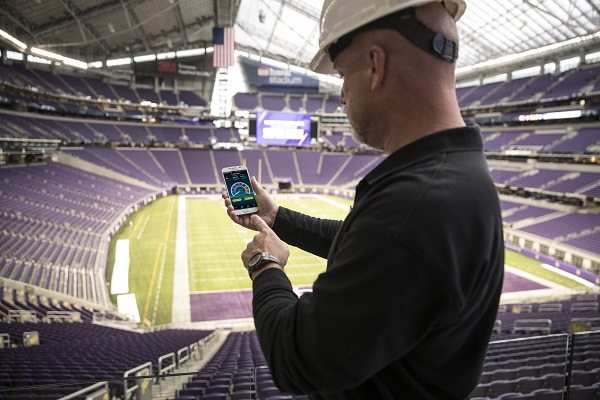As the countdown to this year’s Super Bowl LII begins in earnest, wireless network operators are putting in their final preparations in Minneapolis-St. Paul for the massive amount of data usage that accompanies the biggest football event of the year.
When a city hosts the Super Bowl, it becomes the focus of years of network infrastructure planning and investment, as carriers seek to ensure that their customers are satisfied with their network experience at the big game — particularly in the age of unlimited data plans. Luckily for local customers, most of the capacity and network improvements are permanent investments.
“We have learned that people never stop using their devices,” said Brian Mecum, VP of the West network for Verizon and a veteran of network planning for five Super Bowls. “I like to joke that there are three things people do during the Super Bowl: They are going to the bathroom, eating, or on their phones — only those three. The usage on their phones never stops … [and] there is no place fans don’t want to use their phones.”
More than 1 million visitors are expected in the Minneapolis-St. Paul area for Super Bowl LII, and there are 10 days of activities planned around the event — meaning that operators have had to focus on multiple venues, both indoor and outdoor, as well as transportation hubs, tourist attractions such as the Mall of America (which will also serve as a media center) and even local hotels.
Verizon’s improvements have included 24 new permanent cell sites, as well as more than 230 new small cells — including in bus shelters along Nicollet Mall. Verizon was the lead designer for new fiber-fed, neutral-host distributed antenna systems at the Mall of America and the Minneapolis-St. Paul International airport which all of the carriers signed onto Mecum said — and which boosted Verizon’s capacity at those venues by more than 1,000% in some cases, according to the carrier.
Sprint’s Scott Santi, regional VP for network, said that the event will be “one of the largest data events in the world” and said that the carrier has been working for the past 12 months and investing “hundreds of millions of dollars” on projects that include:
– Utilizing 2.5 GHz small cells to power its DAS acess in the stadium, along with two-carrier carrier aggregation.
-More than 200 small cells installed around Minnepolis-St. Paul, including inside and around U.S. Bank Stadium, and “hundreds” of its Magic Boxes.
– New or upgraded indoor coverage at the Hyatt Regency, Minneapolis Convention Center, Target Center, Minnesota State Fair Grounds, Excel Energy Center and other venues.
T-Mobile US said that it has boosted its LTE capacity in the metro area by up to 35x over the past two years and “focused its network enhancements where the biggest crowds will be”: bumping up capacity by 8x at venues such as the Armory, downtown St. Paul and the Minneapolis-St. Paul International Airport, and concentrating on even higher capacities at Super Bowl-related places. T-Mobile US said that it has increased its capacity 16x at Xcel Energy Center, 35x for the Super Bowl Experience activities at the Minneapolis Convention Center and 30x within U.S. Bank Stadium.
The operator said that it doubled the amount of LTE spectrum that it has in the Twin Cities and launched carrier aggregation, 4×4 multiple input multiple output, and 256 QAM modulation for higher peak speeds.
AT&T said it has invested $40 million in its Minneapolis network, new DAS at 16 locations throughout the Minneapolis area, and 122 new or enhanced nearby cell sites — as well as more advanced LTE features including 256 QAM, 4×4 MIMO and 3-component carrier carrier aggregation.
In addition to the permanent infrastructure, the carrier also plans to have 10 cells on wheels in the area.

